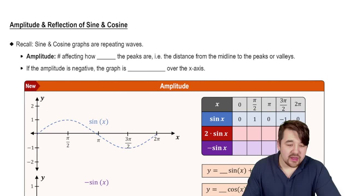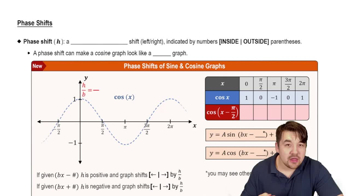Table of contents
- 0. Review of College Algebra4h 43m
- 1. Measuring Angles39m
- 2. Trigonometric Functions on Right Triangles2h 5m
- 3. Unit Circle1h 19m
- 4. Graphing Trigonometric Functions1h 19m
- 5. Inverse Trigonometric Functions and Basic Trigonometric Equations1h 41m
- 6. Trigonometric Identities and More Equations2h 34m
- 7. Non-Right Triangles1h 38m
- 8. Vectors2h 25m
- 9. Polar Equations2h 5m
- 10. Parametric Equations1h 6m
- 11. Graphing Complex Numbers1h 7m
4. Graphing Trigonometric Functions
Graphs of the Sine and Cosine Functions
Problem 4.46
Textbook Question
Determine an equation of the form y = a cos bx or y = a sin bx, where b > 0, for the given graph. See Example 6.
<IMAGE>
 Verified step by step guidance
Verified step by step guidance1
<Identify the type of trigonometric function: Determine whether the graph resembles a sine or cosine function based on its shape and starting point.>
<Determine the amplitude (a): Measure the vertical distance from the midline of the graph to a peak or trough. This value is the amplitude, a.>
<Determine the period: Measure the horizontal length of one complete cycle of the graph. Use the formula for the period of sine and cosine functions, which is \( \frac{2\pi}{b} \), to find b.>
<Determine the phase shift and vertical shift: Check if the graph is shifted horizontally or vertically from the standard position. Adjust the equation accordingly if there are shifts.>
<Write the equation: Substitute the values of a and b into the equation \( y = a \cos(bx) \) or \( y = a \sin(bx) \), depending on the function type identified in step 1.>
Recommended similar problem, with video answer:
 Verified Solution
Verified SolutionThis video solution was recommended by our tutors as helpful for the problem above
Video duration:
0m:0sPlay a video:
Was this helpful?
Key Concepts
Here are the essential concepts you must grasp in order to answer the question correctly.
Amplitude
Amplitude refers to the maximum height of a wave from its central axis. In the context of sine and cosine functions, it is represented by the coefficient 'a' in the equations y = a cos(bx) or y = a sin(bx). A larger value of 'a' results in a taller wave, while a smaller value compresses the wave vertically.
Recommended video:

Amplitude and Reflection of Sine and Cosine
Period
The period of a trigonometric function is the distance along the x-axis required for the function to complete one full cycle. It is determined by the coefficient 'b' in the equations y = a cos(bx) or y = a sin(bx), where the period is calculated as 2π/b. A larger value of 'b' results in a shorter period, causing the wave to oscillate more frequently.
Recommended video:

Period of Sine and Cosine Functions
Phase Shift
Phase shift refers to the horizontal displacement of a trigonometric function along the x-axis. It is influenced by any constant added or subtracted from the argument of the sine or cosine function. For example, in y = a cos(b(x - c)) or y = a sin(b(x - c)), the value 'c' determines how much the graph shifts left or right, affecting the starting point of the wave.
Recommended video:

Phase Shifts

 5:53m
5:53mWatch next
Master Graph of Sine and Cosine Function with a bite sized video explanation from Nick Kaneko
Start learningRelated Videos
Related Practice
















